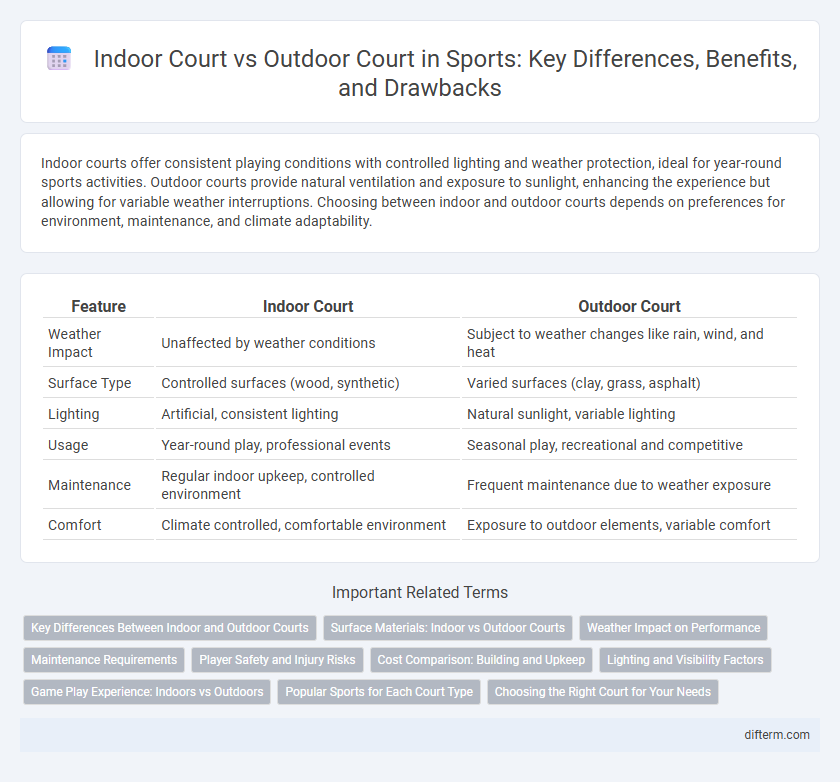Indoor courts offer consistent playing conditions with controlled lighting and weather protection, ideal for year-round sports activities. Outdoor courts provide natural ventilation and exposure to sunlight, enhancing the experience but allowing for variable weather interruptions. Choosing between indoor and outdoor courts depends on preferences for environment, maintenance, and climate adaptability.
Table of Comparison
| Feature | Indoor Court | Outdoor Court |
|---|---|---|
| Weather Impact | Unaffected by weather conditions | Subject to weather changes like rain, wind, and heat |
| Surface Type | Controlled surfaces (wood, synthetic) | Varied surfaces (clay, grass, asphalt) |
| Lighting | Artificial, consistent lighting | Natural sunlight, variable lighting |
| Usage | Year-round play, professional events | Seasonal play, recreational and competitive |
| Maintenance | Regular indoor upkeep, controlled environment | Frequent maintenance due to weather exposure |
| Comfort | Climate controlled, comfortable environment | Exposure to outdoor elements, variable comfort |
Key Differences Between Indoor and Outdoor Courts
Indoor sports courts offer consistent playing conditions with controlled lighting, temperature, and surface quality, minimizing weather-related interruptions and enhancing athlete performance. Outdoor courts, exposed to elements like wind, sun, and rain, often feature more durable materials suited to varying weather but can impact playability and player comfort. Key differences include surface types, environmental control, and maintenance requirements, influencing the choice for specific sports and competitive levels.
Surface Materials: Indoor vs Outdoor Courts
Indoor courts typically feature polished hardwood or synthetic surfaces engineered for consistent ball bounce and player traction, enhancing performance and injury prevention. Outdoor courts commonly use asphalt or concrete coated with acrylic layers designed to withstand weather exposure and provide durability. Surface material selection directly affects gameplay speed, ball behavior, and maintenance requirements across indoor and outdoor environments.
Weather Impact on Performance
Indoor courts provide a controlled environment that eliminates weather variables such as rain, wind, and extreme temperatures, ensuring consistent playing conditions and optimal athlete performance. Outdoor courts expose players to natural elements like sunlight, humidity, and gusty winds, which can significantly affect ball trajectory, grip, and endurance. Weather fluctuations on outdoor courts often lead to unpredictable game dynamics and increased physical strain, impacting overall athletic output.
Maintenance Requirements
Indoor courts require controlled climate conditions to prevent damage from humidity and temperature fluctuations, ensuring the court surface remains consistent and safe for play. Outdoor courts face challenges such as weather exposure, including rain, sunlight, and debris, which demand frequent cleaning, sealing, and resurfacing to maintain durability. Maintenance costs for indoor courts tend to be higher due to HVAC systems and specialized flooring, whereas outdoor courts require more frequent repairs and protective treatments to withstand environmental wear.
Player Safety and Injury Risks
Indoor courts offer controlled environments with consistent lighting and temperature, reducing risks of slips and falls caused by weather conditions like rain or extreme heat. Outdoor courts expose players to variable surfaces and elements such as wind and uneven terrain, increasing the likelihood of injuries including sprains and muscle strains. Protective measures and proper maintenance are essential in both settings to minimize injury risks and ensure player safety.
Cost Comparison: Building and Upkeep
Indoor courts typically require higher initial investment due to construction materials, lighting, ventilation systems, and climate control, with costs averaging $40 to $70 per square foot. Outdoor courts have lower construction expenses, generally ranging from $10 to $30 per square foot, but demand frequent maintenance like resurfacing and weatherproofing to prevent damage. Yearly upkeep for indoor courts can be up to 25% more expensive due to energy consumption and HVAC system maintenance compared to outdoor courts, which rely more heavily on weather conditions and basic cleaning.
Lighting and Visibility Factors
Indoor courts offer controlled lighting conditions that ensure consistent brightness and reduce glare, enhancing visibility for players and referees. Outdoor courts rely on natural sunlight, which can vary throughout the day and cause shadows or glare that affect player performance. Advanced LED lighting systems in indoor arenas provide adjustable illumination, optimizing visibility regardless of external weather conditions.
Game Play Experience: Indoors vs Outdoors
Indoor courts provide a controlled environment with consistent lighting, temperature, and surface quality, enhancing players' focus and precision during gameplay. Outdoor courts expose players to variable weather conditions such as wind, sun, and temperature fluctuations, which can impact ball trajectory, player endurance, and overall game dynamics. The choice between indoor and outdoor courts significantly influences gameplay strategies, requiring adaptations in technique and stamina.
Popular Sports for Each Court Type
Basketball and volleyball dominate indoor courts due to controlled environments that enhance gameplay and reduce weather disruptions. Outdoor courts frequently host tennis and soccer games, leveraging natural lighting and larger spaces for dynamic, fast-paced action. Surface material differences, such as hardwood indoors and concrete or grass outdoors, also influence sport popularity and player performance.
Choosing the Right Court for Your Needs
Selecting the ideal court depends on factors such as weather conditions, maintenance requirements, and playing surface preferences. Indoor courts offer controlled environments with consistent lighting and protection from rain, enhancing year-round playability, whereas outdoor courts provide natural ventilation and a connection to the environment but are subject to weather disruptions. Assessing your training goals, frequency of use, and budget can optimize your choice between indoor and outdoor court facilities.
indoor court vs outdoor court Infographic

 difterm.com
difterm.com